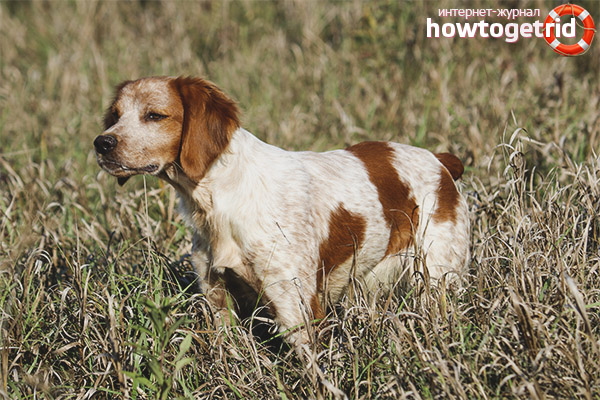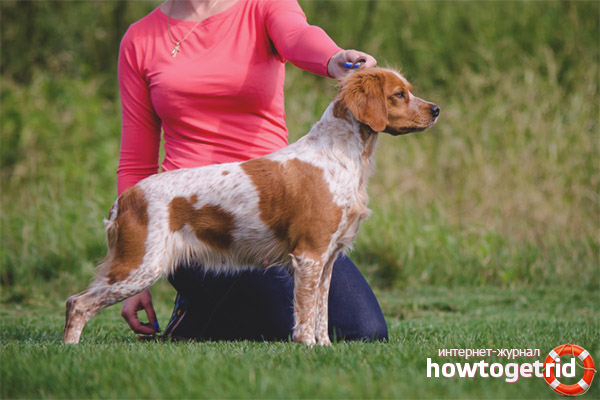The content of the article
Breton epagnol has not only the intricate name of the breed, but also an amazing appearance, which makes the dog popular in various regions. In fact, this is a gundog hunting breed, which is often compared with pointers and setters.
A smart and obedient dog is loyal to the owner with all his soul, gladly fulfills all his commands and is always ready to develop. That is why breton epanyol is an excellent choice as a companion pet or just a family friend.
Origin
For the first time, ancestors began to be bred in the agricultural area of Brittany, which is located in France. The breed is quite ancient, it passed years of transformation and selection, so there is little information about its formation. It is reliably known that representatives come from the province of France, starting from 1900. For one century, the friendly and complaisant dog has gained popularity throughout the country.
The first literary source is dated 1850. In a treatise, a local priest described a dog with a shortened tail, which is ideal for hunting in the north of the country. By 1900, the dog became recognizable, began to participate in exhibitions held in Paris.
A detailed description of the breed (as the first standard) was made by a cavalry veterinarian in 1906. He introduced the world to the dog as a spaniel with a short tail (or all without it) and a double color (red-white, black-white, white-brown). These shades are still breeding in modern Breton epanyol.
In 1907, a male breed named Boy became the first representative officially registered by the cynological community. In the same year, the breed standard was introduced and approved, in which it was given the intricate name "Breton dog with a short tail."
Breed description
Active epanyol is referred to as spaniels, despite the fact that there are significant differences in the appearance and character of these dogs.
Epaniol Breton has an average height - the height in the split of males is up to 50 cm with a weight of 15 to 20 kg. Since this breed is hunting, it must be lean and strong, always at the peak of physical fitness. That is why the body of the animal is muscular and powerful, but in no case thick and not large-bones. It is believed that the spaniel epanyol has the most proportional dimensions (the height at the withers is approximately equal to the length).
The animal is known to everyone for its shortened tail (no more than 10 cm). Sometimes puppies are born without it at all, which cannot be considered a vice. Most have their tail stopped in puppyhood.
The head of the dog is proportional to the size of the body, a shape typical of hunting breeds. The muzzle is slightly elongated, but of medium length. Small and smart eyes have a deep fit, and heavy eyebrows frame them above. The eyes should be dark, but the amber hue is also accepted by the standard. Unlike other breeds, in epagnol, the nose can be dark (black, brown) or pink, depending on the color of the coat.
The animal's snakes reach an average length, but shorter than the spaniel.
The torso is covered with long, wavy (not curly) hair without coats, which also distinguishes the Breton epagnol from its relatives. The length of the coat protects the dog from moving in bushy areas with thickets. Despite the density and density of the coat, the dog does not have an undercoat, so it can freeze at low temperatures. On the legs and ears, the coat is slightly longer, but also without scratching.
Among the colors, the most common is white with a combination of other colors (red, chestnut, black, etc.).
Character and temperament
For many decades, breeders have been monitoring the working qualities of the epagnol, raising a hunting dog from it. Despite this, the breed is distinguished by good nature, playfulness and endless devotion. Animals are successfully transformed into pets "on the pillow", they should return after an exciting hunt. They quickly become attached to the owner and household, are good-natured to guests and other pets, love small children.
It must be understood that the Breton epagnol is completely unsuitable as a guard or service dog, as it will gladly “sell” for a piece of sausage or biscuit. Proper socialization allows the puppy to become an excellent “nanny” for the baby, an older brother for other pets, a friend and companion for an elderly person. Epanjol “wins” even in comparison with the famous companion dogs such as Labrador or American Cocker.
The obedient dog lends itself perfectly to training and is happy to learn new things, pleases its owner. The breed is ideally suited both for pedigree shows and for active events like obedience or agility.
Despite the activity and curiously, the dog is very dependent on the owner and can not endure loneliness for a long time. When getting a little puppy, it is necessary to take a vacation to help the baby get accustomed and socialize, find protection and love of the household.
Breton epanyols are able to work well on their own, but they will happily pair up with another dog or even a pack. It is possible to keep an animal in an enclosure with other breeds, since it does not know dominance, a sense of superiority, a desire to recapture territory, etc.
It is also important to remember that epagnoli are considered one of the most well-trained dogs. They have a high level of intelligence, so the breed was attributed to the 20 most intelligent dogs. She easily fulfills tasks, quickly assimilates basic commands and is suitable for owners who have insufficient experience in training.
The animal is very fond of outdoor games, active pastime, hunting, fishing and tourism, so keeping in a small apartment is not very suitable for them. Muscular physique requires regular high loads, so you need to walk with the animal for hours several times a day. Normally, Breton loves long-term hunting for many hours without a break at any time of the day and weather conditions. If the animal does not waste its natural supply of energy, then shifts in behavior and domination occur. The dog can become timid, nervous, lethargic or angry, bark for no reason, rush about the apartment, spoil shoes or repair.
Care Tips
Breton epanyol does not require special care, not picky about the choice of place, diet, hygiene procedures.
- Woolen cover. It is necessary to bathe the animal once a week with special shampoos and conditioners for wool. Do not forget to comb the hair thoroughly after washing to ensure natural molting.
- The ears. They are a dog’s vulnerability due to their hanging shape and length. Often moisture gets into them, fungi or infection develop, ticks can climb. Inspect the auricles must be daily, cleaned with a sponge and antiseptic.
- Teeth. In order to prevent the formation of soft plaque and rough stone, brush your pet's teeth with special soft brushes and toothpaste. Also stock up on special dental bones for enamel cleansing. Once every six months, record your pet for ultrasonic hygienic brushing.
- Claws. The Breton epagnol spends a lot of time in nature, actively runs and digs in the mud, so the claws grind on their own. However, one should not forget about the claws on the dewclaws, which should be removed with a file.
- Feeding. It is best to transfer the dog to a professional feed for active dogs, as it contains all the minerals and vitamins necessary for the animal. Periodically give the animal large beef bones (make sure that it doesn’t bite, but only bites), as well as cartilage.
The breed is prone to attack by parasites. Fleas, lice, bugs - all living creatures actively breed in thick hair, as well as on the skin and under the skin, causing dry seborrhea, allergies, dermatitis and other skin diseases. Also, helminths are often wound up in Breton, since the animal often spends time outside the house and picks up “excess” from the ground. It is important for the owner to timely anthelmintic the dog, make routine vaccinations, and treat against skin parasites.
Breton epanyol is an ideal breed for a large and active family that respects picnics, hunting, fishing and other outdoor activities. A caring and loyal dog will be a great friend for every household and pet.
Video: Breton dog breed












Submit